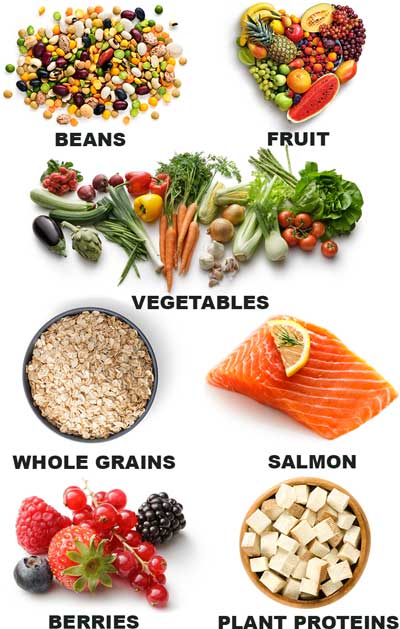A low cholesterol diet is essential for maintaining heart health and reducing the risk of cardiovascular diseases. By following a diet rich in nutritious foods and low in cholesterol and saturated fats, you can significantly improve your overall health and well-being. In this post, we will provide you with a comprehensive guide to creating a low cholesterol diet plan.
Benefits of a Low Cholesterol Diet
Before we delve into the specifics of a low cholesterol diet plan, let’s explore some of the key benefits associated with following such a diet:
- Reduced Risk of Heart Disease: High levels of cholesterol in the blood are a major contributor to heart disease. By lowering your cholesterol levels, you can significantly reduce the risk of developing heart-related issues.
- Improved Weight Management: A low cholesterol diet often involves consuming healthier, nutrient-dense foods. This can help you maintain a healthy weight and enhance your overall body composition.
- Lower Blood Pressure: High cholesterol levels can also lead to high blood pressure. By adopting a low cholesterol diet, you can help regulate your blood pressure and promote better cardiovascular health.
- Enhanced Energy Levels: Consuming a diet rich in fruits, vegetables, whole grains, and lean proteins can provide you with sustained energy throughout the day, keeping you feeling alert and energized.
- Better Digestive Health: Low cholesterol diets often emphasize high-fiber foods, such as fruits, vegetables, and whole grains. These foods promote healthy digestion and can help prevent issues like constipation.
Building Your Low Cholesterol Diet Plan
Now that we understand the benefits of a low cholesterol diet, let’s discuss how you can create a personalized diet plan that suits your needs:
- Choose Heart-Healthy Fats
While it’s crucial to limit saturated and trans fats, it’s important to include heart-healthy fats in your diet, such as avocados, nuts, and olive oil. These fats can help improve your cholesterol levels and reduce inflammation in the body.
 Image Source: Pin on Cooking and Baking Techniques
Image Source: Pin on Cooking and Baking Techniques
- Incorporate Foods Rich in Omega-3 Fatty Acids
Omega-3 fatty acids are known for their ability to reduce inflammation and improve heart health. Include foods such as fatty fish (salmon, mackerel), walnuts, flaxseeds, and chia seeds in your low cholesterol diet plan.
 Image Source: Cholesterol Cheat Sheet | Low Cholesterol Diet Plan
Image Source: Cholesterol Cheat Sheet | Low Cholesterol Diet Plan
- Load Up on Fiber-Rich Foods
Fiber plays a crucial role in maintaining healthy cholesterol levels. Opt for whole grains, legumes, fruits, and vegetables to increase your fiber intake. These foods not only help lower cholesterol but also promote a healthy digestive system.
 Image Source: Low Cholesterol Diet - Diet Plan
Image Source: Low Cholesterol Diet - Diet Plan
- Include Lean Proteins
When selecting proteins, opt for lean options such as skinless poultry, fish, legumes, and tofu. These sources of protein are low in saturated fats and high in essential nutrients, making them an ideal choice for a low cholesterol diet.
 Image Source: Printable One Page List of High Cholesterol Foods
Image Source: Printable One Page List of High Cholesterol Foods
- Limit Sodium Intake
Excess intake of sodium can contribute to high blood pressure. Be mindful of your sodium consumption by reducing the use of processed foods, canned goods, and adding salt to meals. Opt for herbs, spices, and other flavorings instead.
 Image Source: Foods to Decrease Cholesterol
Image Source: Foods to Decrease Cholesterol
- Moderate Alcohol Consumption
While moderate alcohol consumption can have certain health benefits, excessive drinking can negatively impact your cholesterol levels. Stick to low or moderate alcohol consumption, such as a glass of red wine, if permitted by your healthcare provider.
 Image Source: 6 Best Images of Printable Cholesterol Food Chart - Low Cholesterol
Image Source: 6 Best Images of Printable Cholesterol Food Chart - Low Cholesterol
- Stay Hydrated
Water is essential for maintaining overall health, including cholesterol management. Ensure you drink an adequate amount of water throughout the day to stay hydrated and support your body’s natural functions.
 Image Source: +31 Low Cholesterol Diet Plan: Daily Meal Plan to Lower Cholesterol
Image Source: +31 Low Cholesterol Diet Plan: Daily Meal Plan to Lower Cholesterol
- Be Mindful of Portion Sizes
Even when consuming healthy foods, portion control is key. Be mindful of portion sizes to maintain a balanced intake of nutrients and calories. Avoid overeating and try to listen to your body’s hunger signals.
 Image Source: A Low Cholesterol Diet Plan Can Help to Reduce Bad Cholesterol Levels
Image Source: A Low Cholesterol Diet Plan Can Help to Reduce Bad Cholesterol Levels
Creating a Sample Meal Plan:
To help you get started, here’s a sample one-day meal plan that incorporates various low cholesterol foods:
 Image Source: Low Cholesterol Meal Plans - EatingWell
Image Source: Low Cholesterol Meal Plans - EatingWell
In Conclusion
A low cholesterol diet plan is an essential tool for maintaining a healthy heart and reducing the risk of heart disease. By including heart-healthy fats, fiber-rich foods, lean proteins, and following portion control, you can effectively manage your cholesterol levels and improve your overall well-being. Consult with a healthcare professional or a registered dietitian to create a personalized low cholesterol diet plan that suits your specific needs and goals.
Remember, making small changes in your diet can have a significant impact on your long-term health, so start incorporating these strategies today!